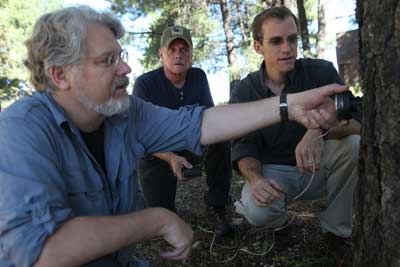Forest scientists at Northern Arizona University, desperate to stop the massive devastation from bark beetle infestation, have recruited a powerful and unconventional force to fight this fierce little bug—Santa Fe musician and composer David Dunn.
Dunn hears beauty in the beetles and has even released a bark beetle CD, The Sound of Light in Trees. With his help, NAU scientists have launched a sonic weapon in the bark beetle battle, and it’s working.
After discovering last spring that the destructive pests were agitated by certain sounds, NAU forest researchers wondered whether these sounds could be used to change bark beetle behavior.
So, on a radio in a lab at NAU, Dunn and forest researchers are playing all beetles, all the time.
“The sound is very similar to just scraping your fingers across the surface of a phonograph record,” Dunn said. “The beetles have grooves in their body parts. They rub them together to create rhythmic, percussive sounds.”
Scientists hear this as a symphony of destruction. “They kind of sound like an angry squirrel,” said NAU entomology professor Rich Hofstetter. “They make clicking and scratching sounds as they chew through the wood or attract mates.”
All that racket is going on inside millions of overcrowded and drought-stressed trees across the West. The dehydrated pine trees can’t create enough resin to push all the bugs out, so creatures the size of a grain of rice are killing entire forests by tunneling through the phloem, or living tissue of the trees.
“It takes hundreds of years to build a forest,” Hofstetter said. “Ponderosa pines are slow-growing trees. They’re actually really well defended typically, but it can take just weeks, sometimes days, for a tree to die.”
Researchers with NAU’s Ecological Restoration Institute say our pine forests evolved naturally with insects like bark beetles that help decompose weak trees. “Our western forests now are crowded with thin, sickly trees that are competing against each other for nutrients,” said ecologist Mike Stoddard. “With predictions of a warmer, dryer West in the long-term forecast, our unhealthy forests are likely to become even more susceptible to unprecedented insect infestations.”
Foot soldiers in the bark beetle battle, Hofstetter and forestry research assistant Reagan McGuire recruited Dunn to help them listen to the trees and record the chatter from the enemy under the bark.
“These insects are sensitive to sound,” Dunn said. “Sound is a part of how they go about sensing and organizing their world and we’re interfering with that.”
They are interfering by introducing a cacophony of bark beetle sounds. “We use several different species and a combination of aggression and courtship calls,” Hofstetter said. “It’s our hope to confuse them and stop their ability to reproduce.”
Using tiny speakers, like the kind you’d find in a musical Hallmark greeting card, the scientists altered the sounds to engage in a sort of sonic warfare with the pests.
“When we play the sounds, it’s very clear the creatures don’t want to be where they are. They become very agitated. The kinds of behavior that have been induced include tunneling in circles, ignoring each other or tearing each other apart,” Dunn said. “If they can’t go about their normal business, the reproductive cycle collapses.”
The scientists used 28 bark beetle couples in an experiment. Fourteen couples were blasted with the mutated beetle sounds; 14 were not.
“The experiment was tremendously successful,” McGuire said. “The control couples produced 200 eggs in tunnels 15 to 30 centimeters long, the kind of tunnel capable of killing a tree. The 14 sound couples produced only one egg collectively and their tunnels were short, only a few centimeters long.”
These scientists appear to have struck the right chord with their acoustic chaos. They are working on a patent to produce a product that will protect individual trees without the use of pesticides. Now their challenge is keeping the beetles from entering the trees in the first place.



